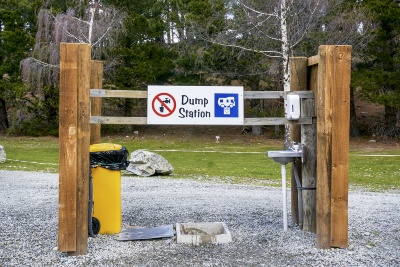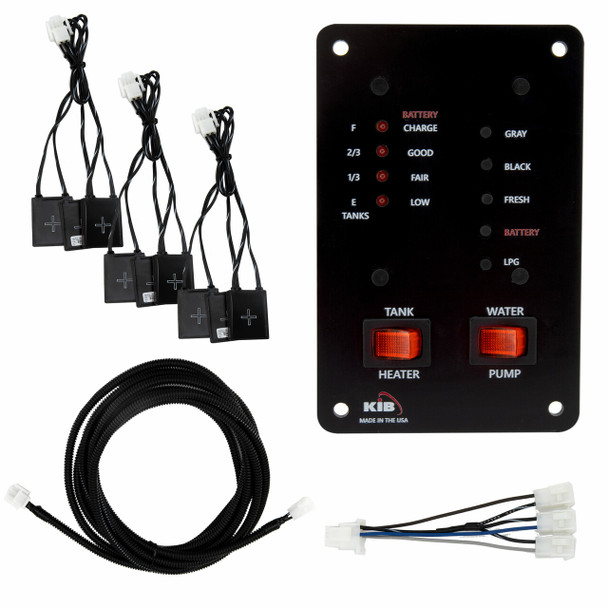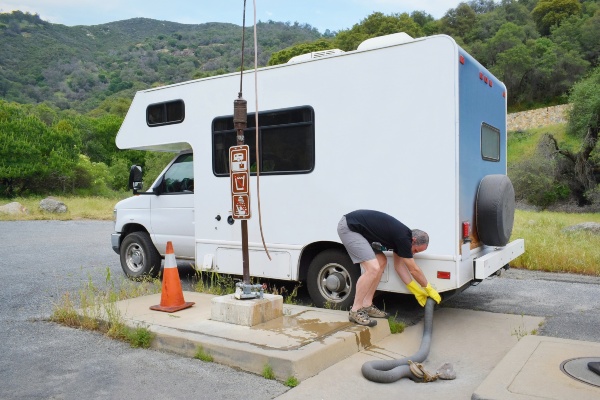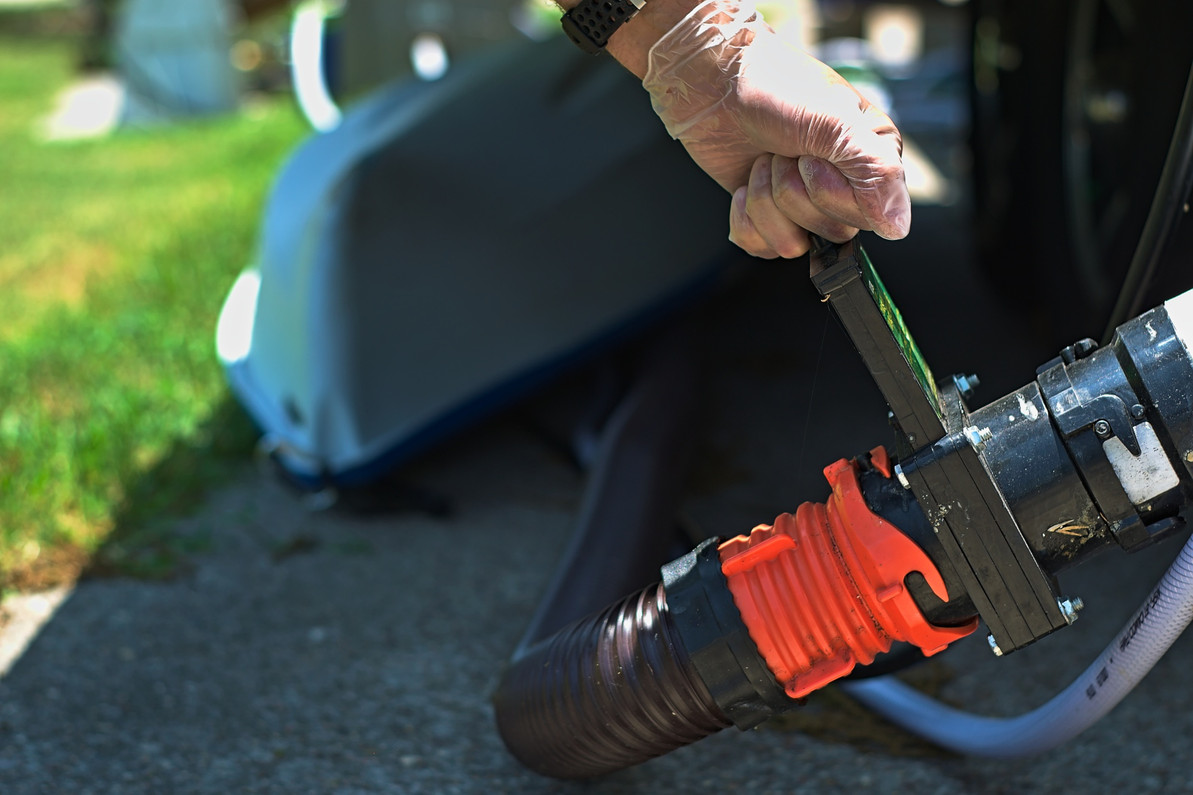The Challenges of Cleaning Your Black Water Tank
The black water holding tank in your RV is susceptible to waste build-up and the formation of harmful bacteria, which can lead to clogs, unpleasant odors, and even leaks. A leak from your black water holding tank is a mess you do not want to be responsible for! To keep your wastewater holding tanks in good working order, it is important to regularly flush and clean these systems. But before you grab your scrub brush, a bottle of bleach, and rubber gloves, you should understand the inherent obstacles that come with cleaning your RV’s black water waste tank. In this article, we will discuss the 3 major challenges associated with cleaning the wastewater holding tanks in your RV.
Obstacle #1 - Requires Approved Dumping Facility

Human waste is considered a biohazard, meaning handling such waste is potentially harmful to your health. The black wastewater tank in your RV has the unique responsibility of storing the hazardous waste from onboard toilets until it can be disposed of properly at an approved dumping facility. Most RV campgrounds will have a dumping station on-site. Beyond campgrounds, dumping stations may be available at rest stops, truck stops, and gas stations. There are plenty of online resources that can help to locate approved dumping facilities for use with route planning. You don’t want a full holding tank on your hands without access to a dumping station.
Oh, and don’t forget the rubber gloves! Disposable gloves are highly recommended when you are dumping your black wastewater tank to avoid direct contact with potentially infectious bacteria and viruses.
Obstacle #2 - Inaccessible to Clean
The last thing you probably want to do is hand wash the inside of your RV wastewater holding tanks. Fortunately, this really isn’t even a valid option since the inside of these tanks is largely inaccessible by hand once installed. While you’re off the hook for hand-scrubbing away stuck-on waste matter, you will need to address this issue in another way. Residual solid wastes can hold on to odor and inhibit the proper functioning of tank sensors if you have them.
The following devices are designed to access the inside of the holding tank and rinse away residual waste and dislodge any stuck-on remnants. This is achieved through either high-pressure spraying or diluting the waste solution with clean water.

Tank Cleaning Wand
Tank cleaning wands simply attach to a garden hose and allow you to spray the inside of your black wastewater holding tank manually. A tank cleaning wand should be used only after the tank has been flushed to wash away residual excess and break down any leftover solids. Tank wands are designed to reach the inside of the holding tank through the toilet drain. Some wands incorporate fancy rotary sprayers, while others utilize a high-pressure stream to blast away stuck-on messes.
Permanent Rotary Tank Rinser
Rotary tank rinsers work similarly to tank cleaning wands but are a permanent, aftermarket option that you must install into your RV holding tanks. This device uses rotary action to spray away stuck-on debris and dislodge odor-causing bacteria that often remain in your black tank even after flushing the system. This tank cleaning method will require you to drill a hole in your black tank to mount the sprayer jet permanently. If you choose this method, be sure that you sealed this new connection thoroughly. The last thing anyone wants is a leaky black water tank!
Macerating Hose System
You may be familiar with macerating toilets, which grind up waste before reaching your RV’s holding tank to prevent clogs and piles from forming in your black water tank. These toilets can be expensive and use lots of electricity, which may not be practical for your RV. There is a product available that similarly breaks up waste so that it flushes out of the tank more easily but does so after it is already in the holding tank and does not use any electricity. A water hose is attached to a high-pressure nozzle connected to the waste valve. The high-pressure nozzle sprays directly into the holding tank when the valve is open to pulverize waste into a slurry. A clear connector lets you see when your tank is flushing clean, and a back-flow valve prevents contamination from occurring within your freshwater source. Also, the high-pressure nozzle is adjustable so that when you finish flushing the tanks, you can also flush the dumping hose.
Built-In Tank Rinse System
Some RVs are manufactured with a built-in tank rinse system to be used during tank dumping. This system works by clean flushing water through the holding tanks as they are being flushed to dilute the waste solution. The additional clean water helps to rinse away waste without residue. If used consistently, this can help keep your holding tanks cleaner on average and reduce the frequency of deep-cleaning treatments.
Reverse Flush Valve
As the name implies, this device allows you to perform a reverse flush of your RV holding tanks. Instead of starting the flush from inside your RV through the toilets as a wand or built-in system would, this device flushes the system from the outside. Once the waste has been dumped, this device is used to quickly refill the holding tank with clean water so that it can be flushed again to remove any waste left behind after dumping.
Obstacle #3 - Good vs. Bad Bacteria

The cleaning devices listed above are efficient at reducing build-up in your tank by increasing the effectiveness of tank flushes, but they do nothing to sanitize the tank or manage harmful bacteria and viruses. Most RV owners find that a deep cleaning treatment is necessary every once in a while to prevent odor-causing bacterial formation, even with regular system flushing. Many types of cleaning solutions are available with varying mechanisms of action, but some are better suited for use in RV holding tanks than others.
For example, bleach is a well-known household cleaning product that disinfects surfaces through a chemical process known as oxidation. Oxidation kills viruses and bacteria by breaking down these molecules at the atomic level. Though bleach is an effective disinfectant, it is not typically recommended for use in your black water holding tank. This is because your black wastewater tank will benefit more from the presence of good bacteria than from a completely bacteria-free environment. Think about how the human gut relies on good bacteria to aid food digestion and fight off harmful bacteria that would otherwise make us sick. The same concept applies to the waste holding tank in your RV. The presence of good bacteria aids in waste breakdown and keeps the levels of bad bacteria at bay.
Enzyme-Based Cleaners
In order to maintain a beneficial balance of bacteria in your waste holding tanks, specialty enzyme-based products are widely available and recommended for use in your RV wastewater tanks. Enzymes are a class of proteins that speed up chemical processes, such as digestion. When added to an RV holding tank, the enzymes help break up the bad bacteria, making it easier to digest for the good bacteria. Imagine the following scenario to understand the relationship between enzymes and bacteria better.
You start a new gig working at a warehouse where your job is to break down cardboard boxes so they can be stored and recycled more easily. You are not given any tools on your first day, so you learn that the best way to break down these boxes is by pulling off the tape that is holding the structure together, then unfolding the box. This is a strenuous activity as the tape is very difficult to remove and often breaks into little pieces. Though this method is difficult and time-consuming, you are able to break down the boxes.
The next day, your boss gives you a blade to use for your job. The blade cuts through the tape easily so that you don’t have to work at pulling off the tape; all you need to do is unfold the boxes. You are still doing the work to break down the boxes so they are flat, but the blade helps you to complete this task more quickly by breaking down a key structural component of the box - the tape.

It may seem silly, but the scenario outlined above represents how enzyme-based cleaners work in your holding tank. In a similar way that you subsist off the paycheck you get from this warehouse job, the good bacteria in your waste subsists by digesting the bad bacteria as “food.” To get paid for your job, you must fulfill your boss’s request and break down the boxes, so they lay flat. For the good bacteria to use the bad bacteria as food, it must also be broken down structurally. Just as you can break down the box without any assistance, the good bacteria can break down the bad bacteria on its own. However, you choose to use the blade for your job because it is much more efficient, so you can break down more boxes and make more money. Enzyme cleaners are used because they help the good bacteria, which are already working in your favor to destroy the bad bacteria, do so more efficiently.
Another reason to choose an enzyme-based treatment over a bleach cleaner or other harsh chemical solution is that most enzyme-based cleaners are biodegradable, making them a more eco-conscious option to use in your RV.
What is your RV holding tank cleaning routine? Is there a particular product or technique that you swear by and would recommend to others? Let us know in the comments!
Recent Posts
-
Can You Put Regular Furniture in an RV?
Many new and old RV owners ask themselves this question when they feel the need to update th …Apr 25th 2024 -
4 Tips for Securing RV Furniture While Traveling | RecPro
How To Secure RV Furniture There are few things that beat going out on an adventure with an RV …Apr 25th 2024 -
How To Keep RV Furniture From Peeling
Peeling RV Furniture | Why it Peels and How to Stop it Your RV furniture is a point of pride on yo …Apr 25th 2024 -
Turning up the Heat With an RV Fireplace
There’s an unlimited number of cool and exciting features you could add to your recreational vehicle …Apr 25th 2024 -
How To Install An RV Fireplace
A Warm Addition to Your On-Wheels: The DIY RV Fireplace Installation Guide Many RV enthusiasts ask …Apr 25th 2024 -
Are RV Electric Fireplaces Safe
Being Safe in Your RV with an Electric Fireplace Safety is always going to be one of your highest …Apr 25th 2024







